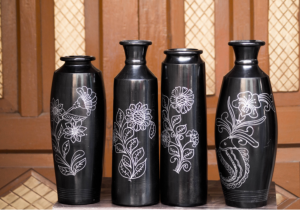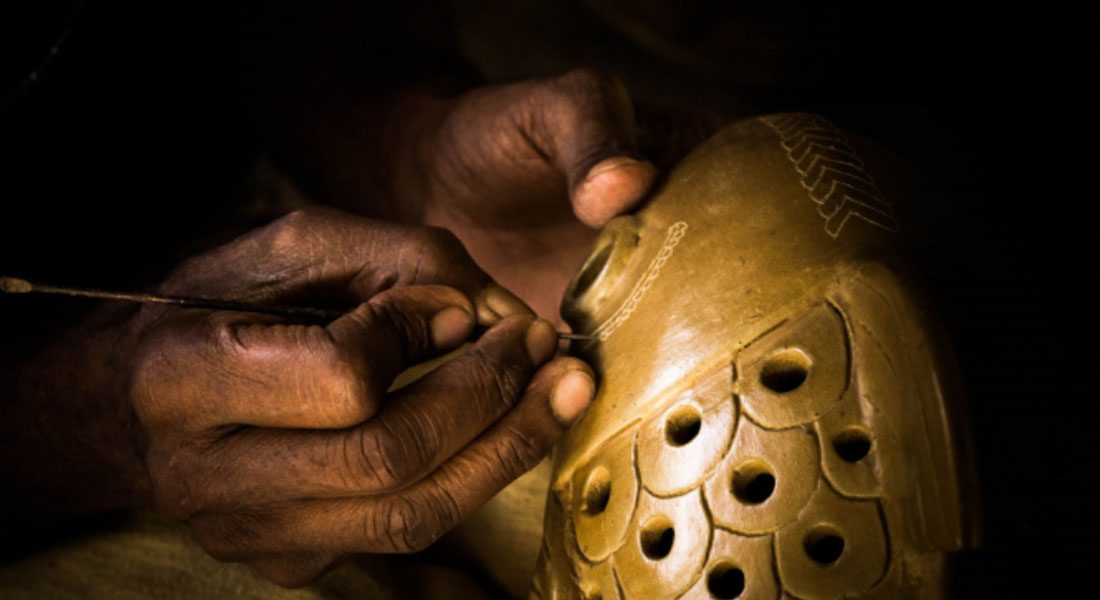India being a country of rich cultural assets and ethnicities has a lot of small villages that still thrive with their distinctive folk arts. However, the respected folk art is less valued in the region itself than it is across the globe. One such art is found in the heart of the country in the state of Uttar Pradesh, known as Nizamabad-Azamgarh black pottery. The moment the word pottery comes to our mind, we assume it just being a mold of clay from a potter’s wheel. Indeed, pottery involves this but our country is known to add various twists in tastes to make every art form different from the one originated mere a hundred kilometers away. Not by artificial colours or paint but this black tint is obtained by a number of steps that the potter takes to finally produce this distinct naturally made black colour. However, certain portions such as the spout or the handle are left out as they are cast separately and then attached to the body. The product is then decorated by incising patterns on the surface for making geometrical patterns.
Area and historical timeline of the village
The small town of Nizamabad is located 25km far from the Azamgarh district of Uttar Pradesh where about only 500 artisans and potters practice this art. Originally, the town is quite old dating back to the time of the Mughals. The town was called Hanumantgarh that was renamed by the invaders as Nizamabad. The feudal rulers had called artisans to reside in this town to make pots, vases somehow influenced by the Persian style. Slowly the talented artisans found out the technique of adding black tint through ash and smoke giving the rise to the famous black pottery hailing from Uttar Pradesh.
Moulding the black pots
Clay moulds and wares are washed with powdered vegetable matter and rubbed with mustard oil. The Prajapati community is said to have been making these pottery from the beginning and it is still practiced in their community. From little store rooms and in-house Karkhanas to new full functioning shops in the market area this art form has its own unique journey. Earlier fine textured clay was locally available easily but due to the course of time and frequent draughts in the region now the artists have to process the clay multiple times to finally reach to the wheel. After giving the final shape on the wheel, the pot is left for a day to dry and gain a firm shape. To attain its beauty, intricate carvings are made through sharpened wooden sticks. Now, these pots are kept rice husks in enclosed kilns which add the black colour and a unique shinny surface to the pots. The grooves made by the sticks are filled with a mixture of zinc, lead and mercury to add the final shine and then the pot is finally polished several times.
Current challenges

A recent interview by INTACH of the Prajapati family highlighted certain issues that their potter community is facing regardless the state government’s numerous initiatives to uplift this vanishing art. With little or no access to bigger markets, most of the individual artisans are supplying their products to local traders in their area. Due to the fragile nature of the terracotta products, the artisans suffer losses in breakage and during the storage. The local people use a lot of black pottery products for their cooking, decoration and day-to-day use. Some of the products are used customarily during weddings in the area (with the custom being that a newly married couple should decorate their rooftop with elephants and horses made of black terracotta). Many of the teashops use the tea cups or kullhars (though these are not of black terracotta) for selling tea locally. A lot of the local inhabitants use clay pots for cooking, storing water and building their roofs. The major being the facilities for import and export of the pots as shipping is a tough ordeal as far as fragile pots are considered. These pots are sold merely to a couple of villages in the neighborhood and the earnings aren’t that great. Three hundred rupees for a piece of art that took days to make is really less and the artisans are now leaving this profession all together.
Lack of proper electricity and resources like furnaces and other equipments have also caused a major setback in the art production. The demand of local art pieces has increased in the city as people are bending back towards the ideals of authenticity. Machine work can never match the brilliance of minute detailing done by men or women. However, the recent years have brought some light on the famous Nizamabad pottery that resembles the Bidri pottery from Hyderabad. Originally the Bidri pottery had carvings that was filled with silver and polished.
To conclude…
The time of Aurangzeb showed the golden age of this art. The Queen of England while visiting India visited the shops of this community and praised their art form. Black pottery is one among many handicrafts of India that is under vulnerability of extinction. At the beginning of this year, the artisan faced a shortage of clay. The paucity of clay is leading artisan to migrate in lieu of better employment opportunities clouding the future of this exquisite art. This is my effort to introduce the world to these crafts so that they could revive these vulnerable crafts of India. It is a must-have souvenir from India. Knowing that the workmanship to produce this masterpiece is unique, black pottery of Nizamabad is still in hope to load the markets globally. Not just the black colour but also the stages involved in refining the mud are extraordinary. Sometimes, goat’s milk is added and the mud is sieved for days to obtain the perfect clay without even the slightest of impurities. The Prajapati community of Azamgarh is leaving no stones unturned to revive this dying art but it cannot flourish if the rest of the communities continue ignoring it.
—
Yashaswini Singh
Master in Heritage Management
—
Other Links:
Image Gallery: Black Pottery of Nizamabad-Azamgarh
—
Keywords: Black pottery, Nizamabad pottery, Azamgarh pottery

